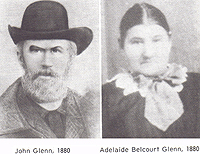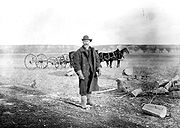
John Glenn (Alberta)
Encyclopedia

John Glenn was the first documented European to settle in the Calgary, Alberta, Canada area. He settled there in 1873 with his wife Adelaide (née Belcourt), and built a small log cabin near the confluence of Fish Creek and the Bow River
Bow River
The Bow River is a river in the Canadian province of Alberta. It is a tributary of the South Saskatchewan River, and is considered the headwater of the Nelson River....
- in today's Fish Creek Provincial Park
Fish Creek Provincial Park
Fish Creek Park is a provincial park located in the southern part of Calgary, Alberta, Canada. It is one of the largest urban parks in North America, stretching from east to west. At , it is over three times the size of Vancouver's Stanley Park....
.
Early life
John Glenn was born in Mayo County, IrelandIreland
Ireland is an island to the northwest of continental Europe. It is the third-largest island in Europe and the twentieth-largest island on Earth...
in 1833. As a young man he left Ireland and travelled to England. He was homesick for his native country so started to travel back home, however he changed his mind just a few miles from his Father's home and turned around and travelled back to England.
From Liverpool
Liverpool
Liverpool is a city and metropolitan borough of Merseyside, England, along the eastern side of the Mersey Estuary. It was founded as a borough in 1207 and was granted city status in 1880...
he took a ship to New York, he was 16 years old. Upon arriving in the United States he decided to travel to Waco, Texas
Waco, Texas
Waco is a city in and the county seat of McLennan County, Texas. Situated along the Brazos River and on the I-35 corridor, halfway between Dallas and Austin, it is the economic, cultural, and academic center of the 'Heart of Texas' region....
where he took employment on a ranch. In 1861 he was drafted into the Confederate Army, however, as he did not believe in slavery, he deserted and joined the Northern Federal Army. He served during this period under General William Tecumseh Sherman until the end of the Civil war in 1865.
He then traveled around the United States, working in mines and in 1867 he moved to British Columbia
British Columbia
British Columbia is the westernmost of Canada's provinces and is known for its natural beauty, as reflected in its Latin motto, Splendor sine occasu . Its name was chosen by Queen Victoria in 1858...
and then on to Barkerville (along with James Votier and Sam Livingston
Sam Livingston
Samuel Henry Harkwood Livingston came to Canada following an unsuccessful venture in the Californian gold rush of 1849, and eventually found his way to Jumping Pound, Alberta in 1873 where he opened a trading post...
- who would later become his neighbours in the Calgary area).
He spent many years as a solitary man, and at the age of 40 he decided, in 1873 to settle down and this is when he married Adelaide Belcourt of Lac Ste. Anne. The marriage took place in the mission in St. Albert (built by Father Lacombe twenty years earlier) and the ceremony was performed by Father Leduc.
They then headed out to find good land to settle on. When they reached Fish Creek they were impressed by the rich soil and decided to make their home there. They built a log cabin in 1873, becoming the first settlers in what is now Calgary. Later he said "I like the climate better than any I have found between the Atlantic and the Pacific; the Rio Grande
Rio Grande
The Rio Grande is a river that flows from southwestern Colorado in the United States to the Gulf of Mexico. Along the way it forms part of the Mexico – United States border. Its length varies as its course changes...
and the Peace
Peace River (Canada)
The Peace River is a river in Canada that originates in the Rocky Mountains of northern British Columbia and flows to the northeast through northern Alberta. The Peace River flows into the Slave River, a tributary of the Mackenzie River. The Mackenzie is the 12th longest river in the world,...
, over all of which Territory I have travelled. There is everything in the country a settler can desire".
The Trading Post
Regular trips by Glenn were made to Fort Benton, to obtain goods to trade, he made one, sometimes two, trips a year in the latter part of the 70's to this end. At the time he had a crew of men. They erected a large dwelling, barn and other buildings, which were completed in 1878-79. This trading post became an established stopping place. Meals were priced at 50 cents each and everyone had to bring their own bed.During this time Glenn started raising cattle and growing grain. After three years the farm constituted 9 acres (36,421.7 m²) sown with oats and barley, a garden and a hay meadow.
John Glenn's Irrigation System
Glenn sold his original farm and trading post to the government on August 1, 1879, thus their first property became Indian Supply Farm number 24. Once sold, the Glenn's moved up the creek to set up another farmstead - near the banks of Fish CreekFish Creek Provincial Park
Fish Creek Park is a provincial park located in the southern part of Calgary, Alberta, Canada. It is one of the largest urban parks in North America, stretching from east to west. At , it is over three times the size of Vancouver's Stanley Park....
, just east of Macleod Trail.
There John Glenn started the construction of his historic irrigation system — this was 19 years before the Alberta Irrigation Company started their first project near Lethbridge
Lethbridge
Lethbridge is a city in the province of Alberta, Canada, and the largest city in southern Alberta. It is Alberta's fourth-largest city by population after Calgary, Edmonton and Red Deer, and the third-largest by area after Calgary and Edmonton. The nearby Canadian Rockies contribute to the city's...
, Alberta
Alberta
Alberta is a province of Canada. It had an estimated population of 3.7 million in 2010 making it the most populous of Canada's three prairie provinces...
.
Glenn built an earth and rock dam about a half a mile west of Macleod Trail and diverted water from the creek in to a ditch which diverted the water to irrigate his fields east of the Trail. This irrigation scheme also worked to supply water for Glenn's nearest neighbour, William Shaw, who arrived from England in 1883 as well as water for the Shaw's woollen mills.
John Glenn's Family

Patrick was the only one to marry and have children. He married Filomene Hodgson, daughter of George Hodgson, Indian Agent at Sarcee Indian Reserve; they had six children.
Regrettably, the story of John Glenn has an unfortunate ending. It is unclear what happened in late December 1885, shortly after the Saskatchewan Rebellion. One story goes that John Glenn's horses may have been spooked, which resulted in him being thrown from his wagon, which resulted in injury (this is the story reported in the Calgary Herald). Another story goes that he and one of his drivers had a difference of opinion which resulted in a fist fight. Regardless of which is true, He never fully recovered and died of pneumonia on January 9, 1886. John Glenn is buried in the pioneer section of St. Mary's Cemetery in Calgary.
After a full and satisfying life, Adelaide died in her 88th year.
In 1999 the original Glenn home was dismantled by the Archeology Field Studies Team of the University of Calgary
University of Calgary
The University of Calgary is a public research university located in Calgary, Alberta, Canada. Founded in 1966 the U of C is composed of 14 faculties and more than 85 research institutes and centres.More than 25,000 undergraduate and 5,500 graduate students are currently...
- they intended to reconstruct the building in its original site - to date it has not been done and there is no indication when or if this will be done (funding is not currently available).
External links
- John Glenn.ca - The story of John Glenn
- Alberta Government - Glenn's short history
- Biography at the Dictionary of Canadian Biography Online

